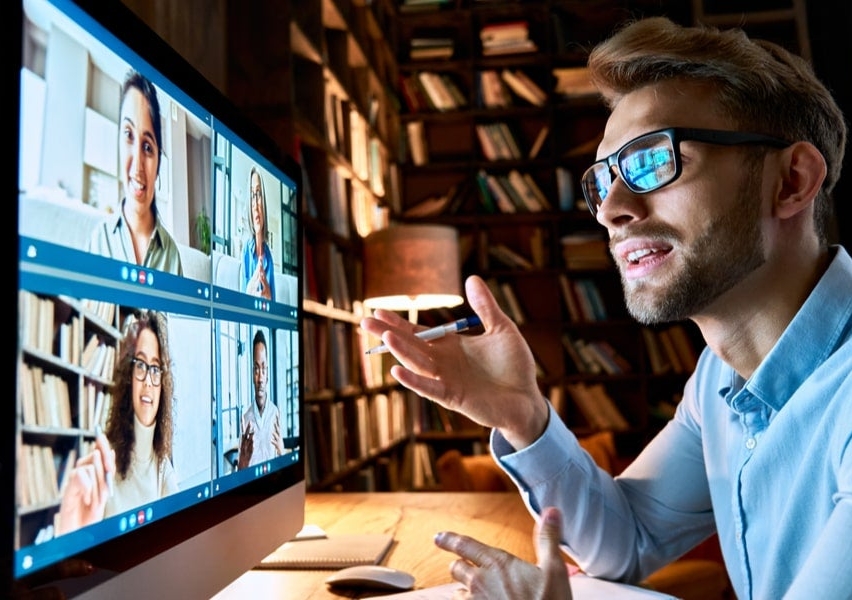The “new normal” of post-COVID workplaces

COVID-19 has upended the world of work for many organisations around the globe. Established ways of working were discarded as many organisations raced to implement remote working in order to comply with government restrictions and lockdowns and reduce potential transmission of SARS-CoV-2.
There are a number of ways COVID changed the way we work and it is a significant catalyst that will reshape how work is performed for decades to come. “I am convinced that we are at the beginning of a turning point,” states Frederik Anseel, an organisational psychologist who serves as Professor of Management and Senior Deputy Dean (Research & Enterprise) at UNSW Business School.
“My guess is that in 30 years we will look back on this period as the catalyst of a new world of digital work and communication. It is, of course, an acceleration of an existing trend; digital work has already been around for more than 30 years. But the acceleration will not be linear, I guess we will talk of a before and an after.”
How did COVID change Microsoft’s way of working?
For work, COVID-19 was a global experiment unlike anything else, and Prof. Anseel said this experiment is starting to yield the first new insights about how we should organise collaboration within and between companies in the future.
Nature Human Behavior recently published a sophisticated analysis of the communication patterns of Microsoft employees in America during COVID-19. “Microsoft is, of course, Microsoft,” said Prof. Anseel. “The company is sitting on a wealth of information because everything is logged, monitored and measured: emails, calendars, scheduled and unscheduled meeting times, text messages, video and phone calls, hours worked.”

The Microsoft study found collaboration and information sharing happens more in silos within organisations.
In collaboration with MIT and Berkeley, every aspect of collaboration was meticulously analysed in the research, which provides a unique look at how an imposed full-time home working regime radically changed collaboration during the first six months of 2020. The uniqueness of this dataset is that Microsoft already had a lot of digital communication and working from home before COVID-19.
“Comparing those digital patterns allows for unusually strong causal conclusions to be drawn: what will happen to human collaboration in a full organisation-wide shift to working from home,” explained Prof. Anseel, who said there are three main conclusions.
The first is that collaboration and information sharing happens more in silos. “This means that you get more isolated groups of people who communicate more intensively with each other, but less with other groups. The flow of information between groups is drying up, which is a problem for innovation. New applications and solutions to problems arise from collaboration between groups,” he said.
The second conclusion is that the network of such groups becomes static. With normal collaboration patterns, Prof. Anseel said people sometimes disappear from networks and new people are regularly added – establishing new relationships in the process. “That’s healthy. New blood provides oxygen. There was anemia due to the work-from-home situation. People do not form new relationships. The network no longer renews itself, which causes a decrease in knowledge creation and decreases the quality of work results.”
The third conclusion revolves around involuntary shifts from synchronous to asynchronous communication. “What do we mean by that?” Prof. Anseel asks. “You work synchronously in a video or telephone call; people are working on the same work at the same time and immediately exchange information with each other. In asynchronous collaboration, people work together at different times. You would expect that an IT company that produced Microsoft Teams is ideally equipped to promote synchronous communication; but even at Microsoft you see the communication shift to email and chat messages.”
The problem with this is that asynchronous media is less “rich”. Such communication is excellent at conveying information, but less suited to conveying the underlying intent and arriving at shared interpretation and mental models, and Prof. Anseel said this undermines the effectiveness of teamwork to solve complex problems.
Hybrid working, social capital and connection
Will Felps, an Associate Professor in the School of Management & Governance at UNSW Business School, said the study provides strong evidence for what many suspected: that remote work reduces spontaneous “water cooler conversations” and collaboration with people you don’t already know well. “You don’t spontaneously meet as many new people working from home,” he said.
“Since remote work undermines connecting and collaborating with people spontaneously, it becomes incumbent on management to ‘structure serendipity’. For example, top leadership could organise occasional speed networking meetings among diverse groups. Or, employees could be asked to report on one new person they’ve met outside their team/unit each week. Or managers could create a ‘relational passport’, where they set up meetings between their direct reports and people outside the team.”
This implies that organisations need to orchestrate employee experiences that have the highest return on social capital, Prof. Anseel said. “Social capital is something new for organisations to think about. Organisations used to think about training, upskilling and developing individual skills or teamworking skills. Developing social capital means thinking about ‘hidden information flows between people’. It is about creating connections between people that normally wouldn’t be connected.”
In a ‘natural’ world, through serendipity and informal encounters, Prof. Anseel said these links would gradually establish. However, in the future, these serendipitous encounters simply won’t occur in the digital world. “Therefore, when planning return to the office and hybrid work schemes, organisations need to design events and allocate time that will allow unconnected teams (not only individuals) who could work together to talk face-to-face and experience how they get work done together,” he said.
“Organisations need to orchestrate and facilitate interactions among those who normally don’t work together and who would be – in a highly structured digital world – unlikely to collaborate. So, this is a bit counterintuitive, but organisations will need to stage meetings between teams that don’t really need each other, because that is where the sweet spot of building social capital is. The future of the office, and its added value, will therefore imply that in-person office time is used to create shared experiences between people that would normally not interact.”
The future of work
As organisations increasingly see the light at the end of the COVID-19 tunnel, Dr Felps said it is important to examine the role remote work will play in the future.
“Going forward, the vast majority of organisations are likely to allow some employees to work remotely at least some of the time. But the big question is whether companies will switch to mostly or even totally remote,” he said.

Most organisations are likely to allow some employees to work remotely at least some of the time.
“My prediction is that most white-collar work will be done remotely even after concerns about COVID-19 have faded (up from roughly 15% prior to the pandemic). Remote work simply has too many economic benefits, such as savings on office rental and the ability to affordably hire great people who don’t live near the office.”
Surveys also suggest that the vast majority of employees prefer working from home, Dr Felps noted. “The remote work genie won’t go back in the bottle. But what the Microsoft study shows is that remote work is likely to undermine innovation and cross-unit collaboration – unless leaders can step in to create opportunities for serendipitous connections.”
Similarly, the Microsoft study’s research team concluded that the effects on collaboration and communication will have a long-term impact on productivity and innovation. Prof. Anseel noted that the study’s authors suggest a hybrid model where employees work on fixed days when all employees go to the office in person, he said. “And that’s a very surprising recommendation for a company that makes a living selling remote work software.”
This story was originally published on BusinessThink.
Kate Bettes is a digital producer, freelance writer and creative mind. Passionate about people and telling their stories in a genuine and digital manner, she works to bring the community together through shared understanding.














